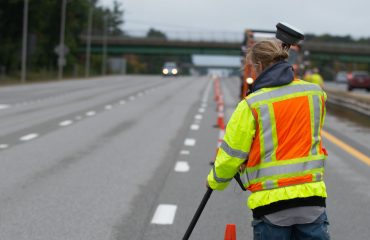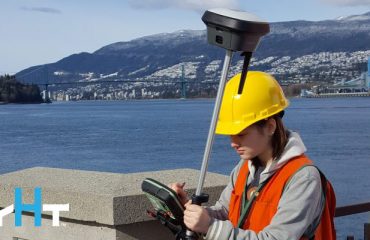Calibration-free tilt compensation for GNSS rovers, introduced in 2017, was a game-changer for surveying, providing significant productivity improvements. It wasn’t long before many professionals began wishing for similar capabilities in prism poles. Seattle-based land surveyor Gavin Schrock said that capability was something he had “hoped to see for decades.”
In the spring of 2022, Gavin’s wish was granted with the introduction of the Leica AP20 AutoPole, a surveying prism pole system with automatic pole height measurements, target identification, and tilt compensation.
Gavin borrowed an AutoPole from survey equipment supplier Kuker-Ranken and took it for a test drive using a test site he has set up on the roof of his building. The trial took place in rainy weather and involved shooting test points in tilt and plumbed pole mode, as well as repeating topo shots conducted previously with other equipment and comparing the data.
“When using tilt-compensated GNSS for some tasks like straight-up topo, I’ve seen gains of 20%-40% over bubble-based operation, as have others I’ve spoken to. But the AutoPole takes this even further as you can pick up shots in places the GNSS simply cannot.”
– SchrockGavin said the PoleHeight option eliminated the need to enter the pole height for all but a few situations. “How much time could the auto height save?” he notes in his review. “That is difficult to say; just how much time is expended in entering new rod heights or noting them in field book. That might not add up to much in the short term, but we all have experienced time lost chasing down a bad rod height after-the-fact—reducing errors could be the biggest benefit from this option.”
He also tested out the Target ID function and found that it “worked better at ignoring other shiny objects and identifying the intended prism” compared to active tracking systems he has used.
“It is impressive that each of the options worked as intended and met or bettered the published specs. And I had way too much fun trying this thing out.”
– SchrockIs it worth the investment? Gavin encourages surveyors to try it for themselves. “Yes, be skeptical of any new tool,” he says, “but some testing will likely impress you.”
Read the full review in GoGeomatics here >
To talk to one of our experts and learn more about how to optimize your surveying potential with technology, please contact us .



